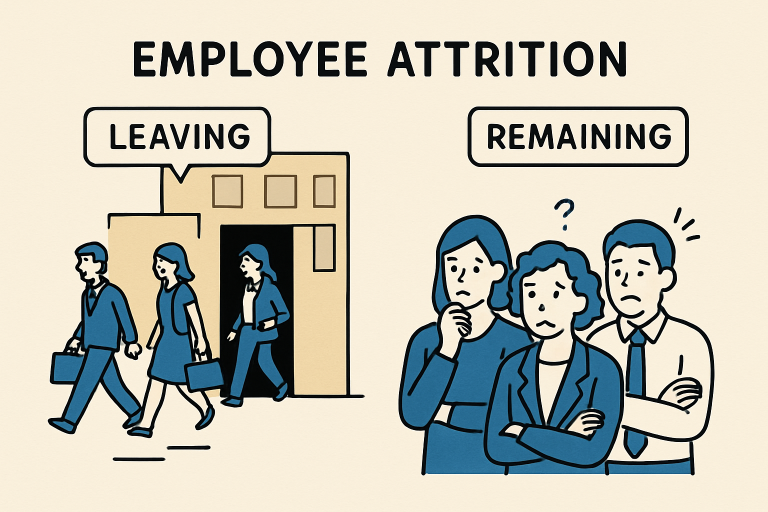The Science Of Employee Attrition: Strategies For Sustainable Workforce Retention
Key Takeaways
- Employee attrition is an ongoing challenge for organizations across industries.
- Understanding root causes can help develop targeted retention strategies.
- Data and regular feedback play a crucial role in mitigating attrition rates.
- Flexible work policies, supportive leadership, and transparent communication are essential.
- Research shows a strong link between employee well-being and attrition reduction.
What Is Employee Attrition?
Employee attrition is the gradual reduction of a company’s workforce as people leave and are not replaced through resignation, retirement, or termination. It’s a critical aspect for HR teams and leadership to monitor, as a high attrition rate can signal underlying issues within the organization.
For organizations aiming to build a thriving culture, tracking and understanding attrition rate is essential to maintaining an engaged and productive workforce. This phenomenon is more than just a number; it reflects employee satisfaction, workplace environment, and company growth prospects.
When attrition goes unchecked, it can snowball into a disruptive cycle, impacting morale, operational effectiveness, and ultimately, the bottom line. Organizations that get ahead of attrition typically have robust systems to monitor staff departures and regularly assess their impact on overall business health.
Common Causes Behind Workforce Attrition
Understanding why employees leave is the first step toward building sustainable retention strategies. Standard drivers include a lack of advancement opportunities, dissatisfaction with management, uncompetitive compensation structures, and burnout from excessive workloads.
According to a 2023 study, 70% of employees who resigned indicated limited career growth as their main reason for leaving. Company culture, poor work-life balance, and feeling undervalued or overlooked frequently show up as secondary yet significant factors.
- No or few advancement prospects
- Unsupportive leadership or management conflicts
- Poor compensation compared to industry standards
- Excessive workload or burnout
- Lack of recognition or appreciation
Other industry factors—such as market instability, mergers, or rapid business changes—can also trigger unexpected waves of attrition, especially when communication is lacking or job security is threatened.

The Cost Of Attrition: More Than Just Numbers
The consequences of high employee attrition are felt across every layer of an organization. Direct costs are substantial—recruiting, onboarding, and training new personnel involve significant investment and time.
However, indirect impacts are often more damaging: remaining staff may experience lower morale, knowledge gaps, and decreased productivity as teams constantly shift to accommodate ongoing turnover. Replacing an employee can cost between 50% and 200% of their annual salary. Such figures clarify why retaining top talent should be front and center on every business agenda.
Detecting Warning Signs Early
Preventing costly attrition starts with keen observation and early intervention. Often, warning signs include declining productivity, a spike in absenteeism, or persistent complaints about job role, leadership, or workload. Exit interviews, pulse surveys, and open feedback channels are essential to surface issues before they result in departures. Savvy companies routinely leverage qualitative and quantitative data—such as frequent one-on-ones or engagement analytics—to spot at-risk teams and act swiftly to address pain points.
Designing a Supportive Workplace Culture
A strong, positive workplace culture is the foundation of any successful retention initiative. Employees who feel valued, included, and empowered are likelier to stay and perform at their best. Leading organizations foster this culture by prioritizing professional development, offering meaningful growth opportunities, and encouraging team collaboration. Simple changes, like flexible schedules or employee recognition initiatives, can reinforce a sense of belonging and loyalty.
Effective Retention Strategies
Retention strategies that work are comprehensive and tailored to both industry and demographics. Industry experts highlight several impactful tactics:
- Consistent, transparent communication from leadership about business objectives and expectations
- Providing ongoing training and clear upskilling pathways
- Mentorship programs connecting less experienced employees with company veterans
- Recognition and reward systems are directly linked to performance and contributions
- Flexibility with remote work, flexible hours, and wellness support
Adaptability is crucial; practices that boost retention in one segment or department may require thoughtful adjustment elsewhere to maximize impact.
Data-Driven Decision Making
Modern HR teams are increasingly turning to analytics to inform their retention strategies. By harnessing people data, organizations can identify workforce trends, predict flight risks, and proactively design interventions tailored to high-risk groups or roles.
Predictive analytics has become a cornerstone in progressive talent management, with research indicating that such data-driven approaches can reduce employee turnover by up to 30%. Leveraging these insights builds organizational resilience and ensures a stronger competitive edge in talent markets.
Fostering Long-Term Success
No company can eliminate attrition, but forward-thinking businesses recognize it as an opportunity for self-assessment and improvement. Building a sustainably engaged workforce demands ongoing commitment to transparent communication, equitable policies, and continuous learning. By prioritizing employee well-being, inclusion, and strong leadership, organizations reduce avoidable departures and cultivate a culture where people want to stay and succeed.







